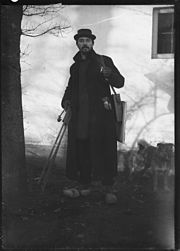Willem Witsen's Human Design Chart
3/5 Emotional Generator**Willem Witsen: A Human Design Perspective**
Willem Witsen was a renowned Dutch impressionistic painter, etcher, photographer, and writer, born on August 13, 1860, in Amsterdam, Netherlands. As a Generator in Human Design, Witsen possessed a unique ability to respond to the world around him, channeling his emotional authority into his artistic endeavors. This characteristic likely influenced his creative process, allowing him to capture the essence of his subjects with depth and sensitivity.
The son of Jonas Jan Witsen and Jacoba Elizabeth Bonekamp, Willem hailed from a wealthy family of “regenten,” the ruling class of the Dutch republic. He studied at the Royal Academy of Visual Arts in Amsterdam and became an active member of influential art circles such as Sint Lucas and Arti et Amicitiae. His artistic style was marked by impressionism, though he also produced somber winter landscapes, which initially met with mixed reviews at his first exhibition in 1895.
Witsen’s Generator energy allowed him to explore his passions freely, and his financial independence enabled him to travel extensively, photographing and painting the world around him. He was known for inviting writers, poets, and fellow artists to stay at his monumental residence, “Het Witsenhuis,” in Amsterdam, fostering a vibrant creative community.
As a member of the “Tachtigers,” an artistic movement between 1880 and 1894, Witsen and his contemporaries sought to break away from the moralistic constraints of the Romantic movement, embracing individualism and a love for nature. This aligns with his 3/5 profile in Human Design, which embodies a blend of experimentation and practical problem-solving, allowing him to navigate the complexities of his artistic journey.
Witsen was friends with notable figures such as painters George Hendrik Breitner, Isaac Israëls, and writers like Lodewijk van Deyssel and Herman Gorter. He supported “De Nieuwe Gids,” an illustrated literary and cultural journal, both financially and through his contributions as an art critic, showcasing his commitment to the arts and his emotional investment in the cultural discourse of his time.
His work gained recognition at prestigious events, including exhibitions at the Venice Biennale in 1895 and 1897, where he won a Gold Medal at the Exposition Universelle in Paris in 1897. The jury praised his poetic approach to art, highlighting his constant search for the elusive, a reflection of his emotional depth as a Generator.
Witsen’s life was marked by personal relationships, including his marriage to Elisabeth van Vloten in 1893, which ended in divorce in 1902, and his subsequent marriage to writer Augusta Maria Schorr in 1907. After Schorr’s passing, Witsen’s legacy continued through “Het Witsenhuis,” which was donated to the state and now serves as a museum, showcasing his contributions to art and culture.
Willem Witsen passed away on April 13, 1932, in Amsterdam at the age of 71. His artistic journey, characterized by his Generator energy and emotional authority, left an indelible mark on the Dutch art scene, and his works remain celebrated for their profound exploration of human experience and nature. For more about his life and contributions, visit the online history project “Het geheugen van Nederland” where much of his correspondence and artwork is preserved.
Discover More Famous People
Browse and analyze over 55,000 public figures and celebrities.
Ra Uru Hu
5/1 Manifestor
Martha Stewart
4/6 Manifestor
David Lynch
4/6 Generator
Barack Obama
6/2 Projector
Steve Jobs
6/3 Generator
Vladimir Putin
5/1 Manifestor
Kim Kardashian
3/5 Generator
Michael Jackson
1/3 Projector
Marilyn Monroe
6/2 Projector
Ariana Grande
2/4 Projector
Oprah Winfrey
2/4 Generator
Johnny Depp
2/4 ManifestorWhat is HumanDesign.ai and how does it work?
Curious what makes Willem Witsen tick? HumanDesign.ai instantly maps their exact birth data into a fully interactive clickable bodygraph chart, letting you hover or tap every center, channel, and gate for plain-language explanations. Bella, the platform’s built-in AI guide, adds context in real time, translating complex mechanics into everyday insights so you can see how Willem Witsen’s strengths, challenges, and life themes play out on-screen.
The same tools are waiting for you. Generate your own Human Design Chart in seconds, open a library of 2000+ suggested questions, and chat with Bella as often as you like to decode your design, daily transits, and even relationship dynamics.
Want to compare energies? Save unlimited charts for friends, family, or clients, then ask Bella to reveal compatibilities, composite patterns, or coaching tips, all in one conversation thread.
Start free with core features, or unlock our Personal and Pro plans for deeper dives: unlimited Q&A, celebrity chart search spanning 55,000+ public figures, white-label PDF reports, branded content generation, and a professional profile with built-in booking for practitioners. Whether you’re exploring your own potential or guiding others, HumanDesign.ai delivers an ever-expanding toolbox of AI-powered insights—no spreadsheets, no jargon, just clarity at your fingertips.
Ready to see yours? Signup for FREE today!

